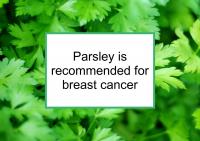Parsley (Petroselinum crispum) is a good dietary source of folate, vitamin C, and vitamin K, as well as some phytonutrients. Parsley has been shown to have potent anti-inflammatory and antioxidant activities, as well as moderate antimicrobial, antifungal, antiviral, radioprotective, antispasmodic, anti-anxiety, and cholesterol-lowering properties.
Because parsley typically does not comprise a large portion of the diet of any group of people, there are no population-based studies that specifically isolate the association between consuming parsley and the risk of cancer. Instead, the epidemiological information available comes from studies in which parsley was a vegetable component of the diet.
Anti-cancer components of parsley
There are numerous studies concerning the anti-cancer components of parsley. Parsley contains 8-methoxypsoralen, which has been shown to inhibit the development of carcinogen-induced lung cancer in laboratory mice. Parsley also is a dietary source of imperatorin and isopimpinellin, which have been shown to have chemopreventive effects in liver, lung and mammary epithelial cells. Parsley leaf oil and parsley seed oil contain myristicin, which has been shown to inhibit the proliferation of carcinogen-induced lung cancer in mice, but which is also toxic to normal cells.
Breast cancer-related effects of eating parsley
A major Italian population study including 2,569 women with breast cancer found that the risk of breast cancer was reduced for increasing intake of flavones and flavonols found in parsley.
Parsley is a source of the flavones apigenin, luteolin, chrysoeriol, the flavonols quercetin, myricetin and isorhamnetin, and the carotenoids beta-carotene and lutein, most of which have been shown to have chemopreventive effects.
Apigenin
Parsley is a very good dietary source of apigenin, which has been shown to exhibit potent growth-inhibitory effects in HER2+ breast cancer cells. Apigenin has also been shown to inhibit the growth of patient-derived triple negative (ER-/PR-/HER2-) organoids and sensitize breast cancer cells to doxorubicin and paclitaxel chemotherapy. In addition, apigenin has been shown to lessen doxorubicin-induced kidney damage without reducing its cytotoxic effects against tumor cells in a mouse model of breast cancer.
Lutein
Lutein consumption and circulating lutein levels have been found to be associated with reduced risk of breast cancer in several epidemiological studies. Lutein has been shown to inhibit the progression of both ER+/PR+ and triple negative breast cancer cells under hypoxia, a low-oxygen condition in which solid breast tumors can thrive. Lutein has also been shown to potentiate the effect of taxane chemotherapy drugs paclitaxel and docetaxel) in breast cancer cells.
Luteolin
Luteolin has been shown to inhibit angiogenesis (new blood vessel formation) and aromatase activity (in which androgens are converted into estrogens) in the laboratory. Luteolin has also been found to suppress triple negative breast cancer cell proliferation and metastasis and to reduce ER+/PR+ cell viability in a dose- and time-dependent manner. In addition, luteolin has been found to inhibit the growth, proliferation and migration of HER2+ breast cancer cells, as well as blocking their acquisition of stem cell-like properties.
Luteolin has also been reported to increase the anti-cancer effects of the chemotherapy drug paclitaxel.
Myricetin
Myricetin has been shown to trigger apoptosis in ER+/PR+, triple negative and HER2+ breast cancer cells. Myricetin has also been reported to inhibit triple negative breast cancer cell migration, invasion, and adhesion and also reduce tumor growth and metastasis in a mouse model of triple negative breast cancer. In addition, myricetin has been found to interfere with tumor cell immortality by preventing telomere extension.
Myricetin has also been shown to increase the oral bioavailability of docetaxel in rats and to enhance the cytotoxic treatment effects of paclitaxel in ovarian cancer cells. In addition, myricetin has been demonstrated to inhibit cisplatin-induced nephrotoxicity in ER+/PR+ breast cancer cells and to reduce heart damage (cardiomyopathy) induced by doxorubicin in an animal model of chemotherapy.
Additional comments
Italian, or flat leaf parsley is named for its leaves, which are flat compared to the curly leaves of common parsley. Cilantro, also called Chinese parsley, consists of the stems and leaves of the coriander plant (coriandrum sativum), which is in the parsley family. The antioxidant capacity of parsley is enhanced when it is used in soups or stews (i.e., when it is boiled) but is reduced when grilled or fried.
Parsley seed oil is an ingredient in some breath freshening products, presumably for its antimicrobial and antiseptic properties. However, the biologically active components of parsley seed oil are very concentrated and it should generally be avoided at all but low doses, especially by those who are pregnant (since it can cause miscarriage), have kidney, heart, or liver disorders, or are on high blood pressure medications, lithium, monoamine oxidase Inhibitors, or opiates.
Non-organic parsley and cilantro must be washed very thoroughly to remove pesticide residue as much as possible.
Sources of information provided in this webpage
The information above, which is updated continually as new research becomes available, has been developed based solely on the results of academic studies. Clicking on any of the underlined terms will take you to its tag or webpage, which contain more extensive information.
Below are links to 20 recent studies concerning this food and its main components. For a more complete list, including less recent studies, please click on parsley.
